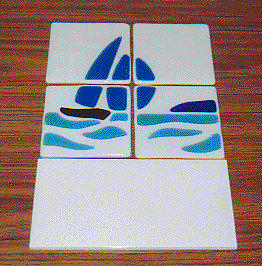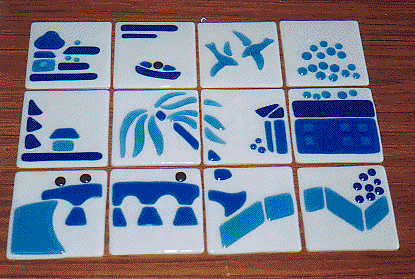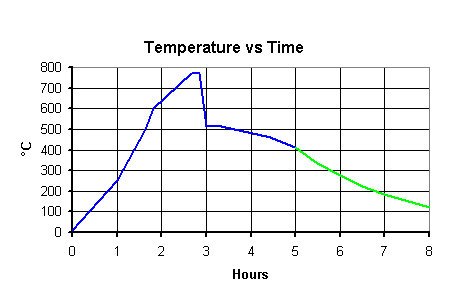 |
| A unique feature for your bathroom or kitchen |
 |
| Yacht under spinaker. Designed to fit in space of 200x200mm ceramic tile. Four 100x100mm glass tiles, 6mm thick, Spectrum System 96, 2001. (All tiles are actually just under the stated size to allow for grouting. 100x200mm white glazed ceramic tile shown underneath for comparison.) |
 |
| Richmond Willow Pattern. 2001. 100x100 tiles, System 96. An interpretation of the traditional Willow Pattern ceramic ware in an Australian idiom, using typical Aussie houses rather than tea-houses and the Richmond Bridge (oldest in Australia). The Coal River at Richmond does actually have willows along its banks. |
| Technique |
| I use System 96 (Spectrum and Uroboros) for these tiles. White opal 200SFS is cut into squares of 96mm sides. Clear 100SF is cut into similar squares of 95mm side, so there is a slight opal overhang all around. The two layers make a final tile of about 6mm thick, approximating the thickness of ceramic tiles, and also the thickness preferred by the glass surface tension and weight. (Clear on white works too, but the resulting tile is less white more cream, and the pattern pieces seem to float above the surface. For some things this might be a good effect.) |
| The pattern pieces are cut from a palette of cobalt blues (130.8SF, 132SF and 136SF), black 1009SF and Uroboros black iridized. It is also sometimes useful to put small clear 100SFS pieces on blue to fuse down and make lighter patches (see houses in Richmond Willow Pattern), or small pieces of the blues to make darker patches on a lighter blue. The pattern pieces are sometimes pre-fired to round them off or make some special gradient. Pattern pieces must be kept at least 3mm from the edge of the square or the extra glass will push the edge out of straight when it fuses. |
| The kiln schedule has a fast initial heating cycle (because small pieces, unfused), but slowly from 600 to 770°C through the slumping and fusing range to minimize bubbles between the white and clear (a modified Reynolds squeeze). I use a light fuse temperature (770°C) to retain some surface relief from the pattern pieces and reduce edge distortion. The down phase is based on Graham Stone's schedule on p10-95 of his book. After reaching 410°C the power is turned off and the kiln cools unpowered. |
|
 |
| © Copyright 2001 AHJ Sale |
| Page last modified on 2001 October 24 |